
| (one synonym : Chaerocampa deserta Butler, 1876) MACROGLOSSINAE, SPHINGIDAE, BOMBYCOIDEA | (donherbisonevans@yahoo.com) and Stella Crossley |
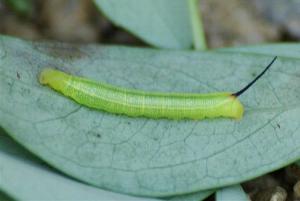
early instar
(Photo: courtesy of Tom and David Sleep, Queensland)

| (one synonym : Chaerocampa deserta Butler, 1876) MACROGLOSSINAE, SPHINGIDAE, BOMBYCOIDEA | (donherbisonevans@yahoo.com) and Stella Crossley |

early instar
(Photo: courtesy of Tom and David Sleep, Queensland)
Early instars of this Caterpillar are initially green with a pair of pale lateral lines, and a dark spike on the tail which curves slightly forward. Later instars may be brown or green, and develop an eyespot each side of the first abdominal segment.
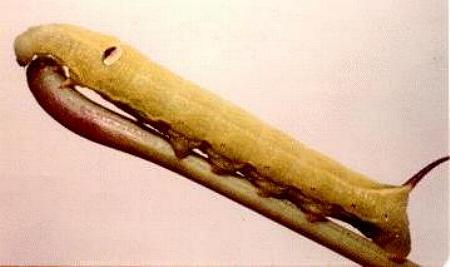
Final instars may be green, or brown with a diagonal stripe on the side of each segment. the spike on the tail curves backwards and ends in a sudden point. The spike is quite harmless.
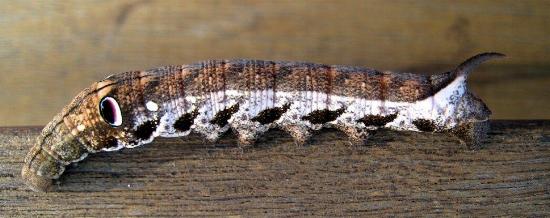
In the fourth and fifth final instars: the eyespot on each side the first abdominal segment develops some red coloration. They also sometimes have a minor eyespot on the second abdominal segment.
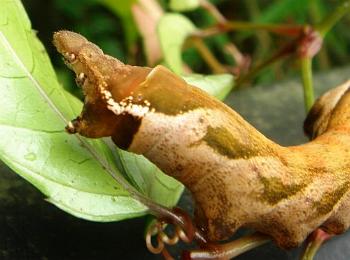
Normally the main eyespot is hidden by a fold in the skin of the first abdominal segment, and the spot is only displayed when the animal is disturbed. Indeed when the skin is folded, the head and prothorax look like the upper jaw, and the first set of legs like teeth in the lower jaw, of some much larger beast, which may deter predators.
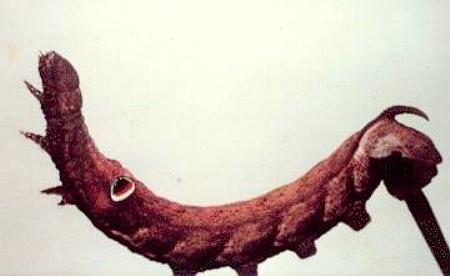
The caterpillar has been found feeding on a wide variety of plants, but it is most often found on plants in VITACEAE, such as
The caterpillars have also been found on :
Early instars shelter by day under a foodplant leaf, lying along the midrib. The caterpillars grow to a length of about 8 cms.
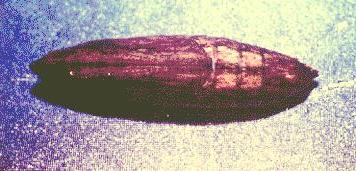
The caterpillar pupates in a cocoon incorporating debris on the ground near its foodplant. The pupa is brown with some dark markings, and is symmetrically streamlined at both ends. The pupa has a length of about 5 cms.
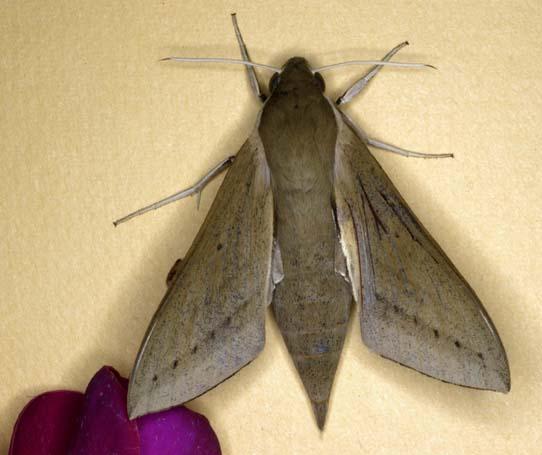
The adult moths of this species have plain brown forewings, each with some faint darker lines, a submarginal line of faint dark dots, and a single subcostal black dot. The moth has a wing span of about 7 cms.
The adult moths have some slightly darker banding across the abdomen, which may be used to distinguish them from the related species Theretra tryoni. The adults of these two species may be barely distinguishable, but the caterpillars are easily distinguished, having only one eyespot on each side, whereas Theretra tryoni caterpillars have two.
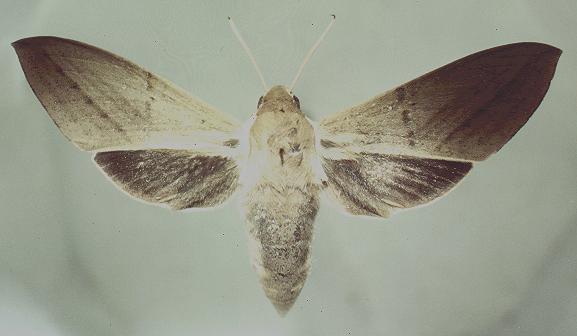
The eggs are oval and pale green, with a length up to 2 mms. They are laid singly on a leaf of a foodplant.
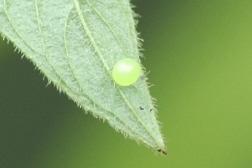
The species has been found in :
and over the northern tropical and subtropical regions of Australia, including
Some taxonomists in the twentieth century tried to change the name to Theretra latreillei in memory of the Lepidopterist Pierre Latreille, but this was disallowed as contrary to the international rules on nomenclature, which allow only the author of the first description of the species to name it.
Further reading :
Ian F.B. Common,
Moths of Australia,
Melbourne University Press, 1990, fig. 42.1, pl. 29.12, pp. 38, 71, 415.
William Sharp Macleay,
Annulosa,
in Philip Parker King :
Narrative of a Survey of the Intertropical and Western Coasts of Australia,
Volume 2 (1826), Appendix B, p. 464, No. 165.
Maxwell S. Moulds, James P. Tuttle and David A. Lane.
Hawkmoths of Australia,
Monographs on Australian Lepidoptera Series, Volume 13 (2020),
pp. 247-250, Plates 64, 81, 91.
Buck Richardson,
Tropical Queensland Wildlife from Dusk to Dawn Science and Art,
LeapFrogOz, Kuranda, 2015, p. 203.
Paul Zborowski and Ted Edwards,
A Guide to Australian Moths,
CSIRO Publishing, 2007, p. 169.
 caterpillar |  butterflies |  Lepidoptera |  moths |  caterpillar |
(updated 7 April 2013, 18 April 2017, 15 November 2020)